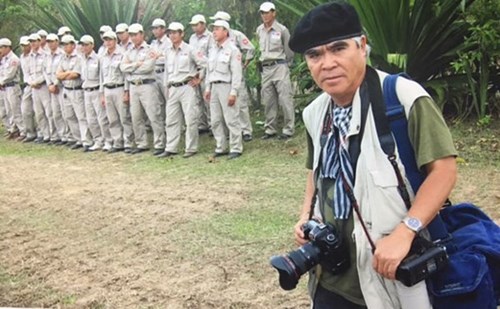Reporter: Do you think that the photo “Napalm girl” and other photos you took depicting children hit by napalm bombs in Trang Bang changed your life forever?”
    |
 |
|
Journalist-photographer Nick Ut |
Journalist-photographer Nick Ut: I took the “Napalm girl” photo when Phan Thi Kim Phuc (the girl in the photo) was just nine years old. After taking that photo, I brought Kim Phuc to the hospital and she was saved. It could be said that that historic photo changed my life and my career. The photo left deep impressions on the public in various countries. It helped boost the anti-war movement and encouraged people around the world to voice their aspirations for peace. The photo was posted on the front pages of a good number of known papers in the world and it won me the reputable US Pulitzer award in 1973.
For years, Kim Phuc and I have kept in touch. We consider each other family members and share stories about our families and our lives.
Reporter: You’ve talked with a lot of Vietnamese and foreign students about maritime sovereignty and the photo “Napalm girl”. What were your feelings about those meetings?
Journalist-photographer Nick Ut: I’ve been even busier since I retired from the Associated Press news agency (AP). That is because I’ve received a lot of invitations to talk with university students about the war in Vietnam. They study history and understand deeply the Vietnamese history. Via the photo “Napalm girl”, I’ve helped them understand better the brutality of war. In most of the meetings, quite a few students couldn’t hold back their tears. The top honor for me is that my press work has touched the hearts of the audience.
Reporter: As a reputable journalist in the press sector, do you have any recommendation for students and young journalists these days?
Journalist Nick Ut: I think if you have the passion for and pursue a press job, you should be strict at work and ever-ready for a charge forwards for your career. A successful journalist must not overuse Photoshop. For press work, truthfulness is the best policy. For example, if unfortunately, you did not have a photo at work, you should use a photo for illustration, not a photos hoped one. Reporters are now equipped with a lot of support kits and they are also very quick at work. A lot of young Vietnamese journalists have won national and international press awards. That is a promising sign for the press circle in Vietnam.
Reporter: You donated one of your items to the Vietnam Women’s Museum last year. On the occasion of the Vietnamese Revolutionary Press Day this year, you’ve given away a lot of display items to the Vietnam Press Museum. How do you feel about your donation?
Journalist Nick Ut: I am very happy when a lot of people want me to donate my documents and photos I produced during the war in Vietnam. However, I told them that I am a Vietnamese; therefore, I want to donate my things to my compatriots.
Among the items that I’ve donated to the Vietnam Press Museum, are a number of cameras that the AP gave me for doing my job and a lot of photos about the war in Vietnam. I would like to send the museum those photos and items associated with my press career in Vietnam so that Vietnamese students may later learn more about their previous generations of journalists.
Reporter: Thank you very much!
Interviewer: Khanh Huyen
Translated by Huu Duong